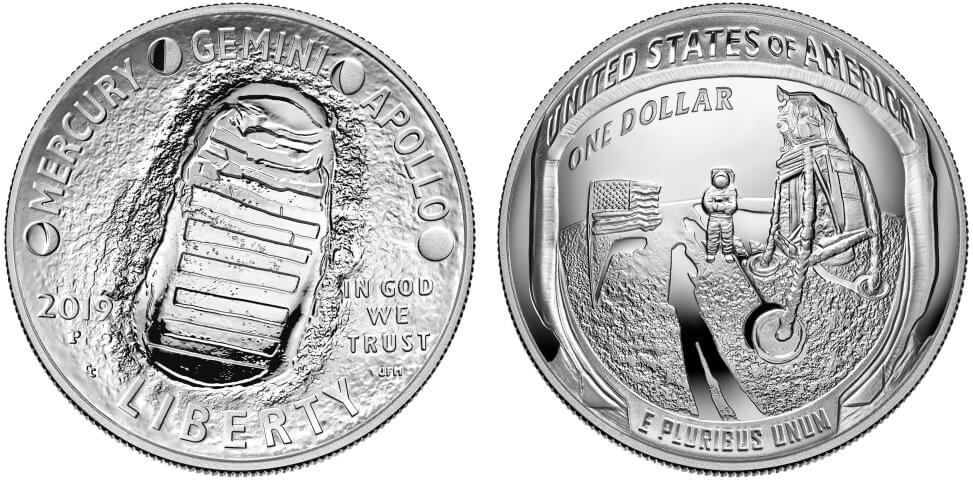The July 20, 1969 Apollo 11 moon landing—one of the greatest achievements of the human race that has had enormous implications for the advancement of science and technology partly by encouraging so many people to pursue careers in those fields—had not been the sole subject of an American coin before 2019. It was celebrated on many world coins starting in 1969 and served as the basis for the reverse side of the Eisenhower dollar, but that seemed inadequate to the momentousness of the event as an American triumph.
Proposed by Iowa banker Michael Olson to commemorate the 50th anniversary of the moon landing
In 2014, while serving on the Citizens Coinage Advisory Committee, Iowa banker Michael Olson, proposed that the Mint issue a commemorative coin program in 2019 to mark the 50th anniversary of the moon landing in which each coin would be curved like the 2014 Baseball Hall of Fame coins. And in addition to the standard trio of silver dollar, $5 gold coin and clad half dollar, he also suggested that a new type of coin be issued: a 5-ounce curved Proof, plus a special set with a Kennedy half dollar that was paired with the Apollo 11 half dollar and only available in that set.
The obverse design for these coins was selected through a design competition required by the program’s authorizing law, Public Law 114-282. The winning design by Maine artist Gary Cooper has as its central motif the iconic boot print of astronaut Neil Armstrong as he stepped onto the moon’s surface surrounded by legends for Mercury, Gemini and Apollo separated by phases of the moon. Joseph Menna sculpted it.
The reverse was designed and sculpted by Mint sculptor-engraver Phebe Hemphill and is a representation of a close-up of the famous photo Buzz Aldrin took on the moon that shows just the visor and part of his helmet with a reflection of Armstrong, the US flag and the lunar lander.
These designs were unveiled on October 11, 2018 at an event at the Smithsonian Institution’s Air and Space Museum that included several living astronauts and both sons of Neil Armstrong.
The coins went on sale on January 24, 2019 with the uncirculated silver dollar priced at $51.95 and the Proof at $54.95 until February 25 when the prices of each coin were increased by $5.
These coins also marked the first time that commemorative silver dollars were struck not in 90% silver and 10% copper as they had been since 1892, but instead in the new standard for all U.S. Mint silver coins beginning in 2019, which is 99.9% fine. The previous alloy, known as coin silver, had became expensive to use since it was not the standard used by other world mints, which were using .999 or finer silver for coins.
The Apollo 11 coins were one of the most successful coin programs in recent history
They were very strong sellers from the start with an authorized maximum mintage of 400,000 silver dollars and no product or order limits. In just the first two days, the Proof (Buy on eBay) sold an amazing 105,136 and the mint state coins (Buy on eBay) 38,728.
Final sales were 59,697 for the uncirculated coin and 218,751 for the Proof, which was the first time in almost 20 years that over 200,000 of any commemorative dollar had been sold.
The overall program (all coins) raised a very impressive $8 million in surcharges, including $10 from the sale of each silver dollar—of which half went to the Smithsonian’s Air and Space Museum for its exhibit on the moon and the other half was split between the Astronaut Memorial Foundation and Astronaut Scholarship Foundation.
Coin specifications
- Designer: Gary Cooper (obverse), Phebe Hemphill (reverse)
- Weight: 26.730 grams
- Composition: 0.999 fine silver
- Diameter: 38.1 mm (1.5 inches)
- Maximum authorized mintage: 400,000
2019-P Uncirculated Apollo 11 50th Anniversary Silver Dollar
- Pre-issue price: $51.95
- Regular price: $56.95
- Final mintage: 38,728
2019-P Proof Apollo 11 50th Anniversary Silver Dollar
- Pre-issue price: $54.95
- Regular price: $59.95
- Final mintage: 218,751


